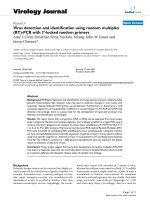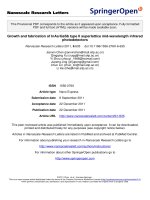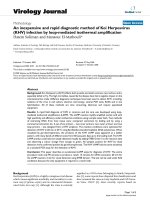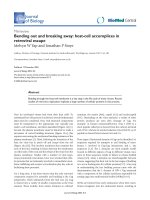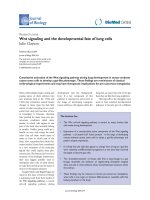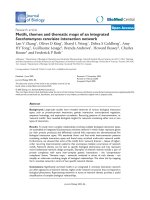Báo cáo sinh học: "Growth, carcass and meat quality performance of crossbred pigs with graded proportions" doc
Bạn đang xem bản rút gọn của tài liệu. Xem và tải ngay bản đầy đủ của tài liệu tại đây (998.45 KB, 17 trang )
Original
article
Growth,
carcass
and
meat
quality
performance
of
crossbred
pigs
with
graded
proportions
of
Meishan
genes
JP
Bidanel
JC
Caritez
2
J
Gruand
C
Legault
1
INRA,
Station
de
Génétique
Quantitative
et
Appliquée,
Centre
de
Recherches
de
Jouy-en-Josas,
78352
Jouy-en-Josas
Cedex;
2
INRA,
Domaine
Expérimental
du
Magneraud,
17700
Surg!res;
3
INRA,
Station
Expérimentale
de
S61ection
Porcine,
86/!80
Rouillé,
France
Summary -
Growth,
carcass
and
meat
quality
traits
were
measured
in
2
different
experimental
herds
on
male
and
female
pigs
produced
from
matings
between
Pietrain
boars
and
12
genetic
types
of
sows
with
graded
proportions
of
Large
White
(LW)
and
Meishan
(MS)
genes.
Growth
records
(from
30-100
kg
liveweight)
were
obtained
on
ad
libitum
feeding
on
a
total
of
1 640
pigs,
among
which
1 200
were
submitted
to
carcass
evaluation
and
meat
quality
measurements.
Genetic
type
mean
performance
essentially
varied
according
to
the
relative
proportions
of
MS
and
LW
genes
in
the
dam
and
could
hence
be
characterized
by
a
single
parameter,
difference
in
crossbreeding
(!;yls_LW)!
which
measures
the
difference
between
MS
and
LW
breeds
used
as
dam
breeds.
Differences
in
crossbreeding
were
unfavourable
to
MS
for
all
growth
and
carcass
traits.
Average
estimates
of
.ð.
M
S-LW
were
-71±16
g/d;
0.21!0.07;
-2.4!0.3% ;
-9.0±0.5%
for
average
daily
gain
(ADG)
feed
conversion
ratio,
killing
out
percentage
and
estimated
carcass
lean
content
(%
M),
respectively.
However,
significant
herd
differences
were
observed
for
ADG
and
%M.
The
2
herd
estimates
were -51±
16
g/d
and
-92::!::30
g/d
for
ADG, -7.3±0.6%
and - 10. 7 +
1.5%,
for
%M.
Conversely,
differences
in
crossbreeding
for
meat
quality
traits
were
in
favour
of
MS,
with
an
advantage
of
1.1
t 0.4
point
in
meat
quality
index
over
LW,
ie
one
third
of
a
phenotypic
standard
deviation.
pig
/
crossbreeding
/
Chinese
breed
/
growth
/
carcass
/
meat
quality
Résumé -
Performances
de
croissance,
de
carcasse
et
de
qualité
de
la
viande
de
porcs
comportant
une
proportion
variable
de
gènes
Meishan.
Des
performances
de
croissance,
de
carcasse
et
de
qualité
de
la
viande
ont
été
mesurées
dans
2
élevages
expérimentaux
sur
des
porcs
mâles
et
femelles
issus
d’accouplements
entre
des
verrats
Piétrain
et
12
types
génétiques
de
femelles
comportant
des
proportions
variables
de
gènes
Large
White
(LW)
*
Correspondence
and
reprints
et
Meishan
(MS).
Le
contrôle
de
croissance
(de
30
à
100 kg
de
poids
vif)
a
été
réalisé
en
alimentation
à
volonté
sur
un
total
de
1 6/0
porcs,
dont
1200
ont
fait
l’objet
d’une
évaluation
de
la
qualité
de
la
carcasse
et
de
la
viande.
Les
performances
moyennes
des
différents
types
génétiques
varient
essentiellement
en
fonction
des
proportions
relatives
de
gènes
MS
et
LW
chez
la
mère
et
Peuvent
donc
être
caractérisées
par
un
paramètre
unique,
la
différence
en
croisement
(!Á1S-LW)’
qui
mesure
l’écart
entre
les
races
MS
et
LW utilisées
comme
mères
des
produits
terminaux.
Les
difJérences
en
croisement
sont
en
défaveur
de
la
MS
pour
l’ensemble
des
caractères
de
croissance
et
de
carcasse.
Les
estimations
moyennes
de
!Á1S-LW
s’élèvent
à
-71±16
g/j;
0,
21t0, 07 ;
-2,4::1::0,2%
-9, OfO, 5%
pour le
gain
moyen
quotidien
(CMQ),
l’indice
de
consommation,
le
rendement
et
la
teneur
esz
muscle
estimée
(%M)
de
la
carcasse,
respectivement.
Cependant,
des
différences
significatives
entre
élevages
sont
observées
pour
ADG
et
%M.
Les
estimations
des
2
élevages
s’élèvent
à -51 f
16
g/j
et
-92 !
30
g/j
pour
GMQ;
-7, 3 !
0, 6%
et
-10, 7 t
1,
pour
%M. À
l’inverse,
les
différences
en
croisement
pour
les
caractères
de
qualité
de
la
viande
sont
en
faveur
de
MS,
avec
un
avantage
de
1,
1 t
0,
4 point
d’indice
de
qualité
de
la
viande
sur
LW,
soit
un
tiers
d’écart
type
phénotypique.
porcin
/
croisement
/
race
chinoise
/
croissance
/
carcasse
/
qualité
de
la
viande
INTRODUCTION
Some
native
porcine
breeds
from
China,
such
as
the
Meishan
Lreed,
exhibit
ex-
ceptional
reproductive
ability
compared
to
currently
used
maternal
genotypes
and
could
be
of
great
value
for
improving
sow
productivity
(Legault
and
Caritez,
1983).
However,
these
Chinese
breeds
are
also
characterized
by
very
poor
growth
and
carcass
performance
(Legault
et
al,
1985).
Hence,
their
economic
value
will
largely
depend
on
the
relative
economic
contributions
of
productive
and
reproductive
traits.
Several
crossbreeding
schemes
can
be
implemented
in
order
to
take
advantage
of
these
extreme
genotypes
(Sellier
and
Legault,
1986;
Bidanel,
1990).
Their
economic
value
can
be
assessed
using
the
knowledge
of
a
limited
number
of
crossbreeding
parameters
(Dickerson,
1969,
1973;
Hill,
1982).
Accordingly,
an
experiment
was
designed
to
estimate
crossbreeding
parameters
relative
to
the
cross
between
one
of
these
Chinese
breeds,
the
Meishan,
and
the
most
widely
used
French
breed,
the
Large
White,
for
the
main
traits
of
economic
interest.
Estimates
of
crossbreeding
parameters
for
sow
productivity
and
growth
traits
have
been
reported
by
Bidanel
et
al,
(1989,
1990)
and
Bidanel
(1993).
The
purpose
of
the
present
study
was
to
evaluate
the
growth,
carcass
and
meat
quality
performance
of
crossbred
pigs
with
various
proportions
of
Meishan
genes
and
estimate
the
relevant
crossbreeding
parameters.
Pi6train
boars
were
used
as
terminal
sires.
MATERIALS
AND
METHODS
Data
and
experimental
design
The
data
originate
from
a
crossbreeding
experiment
between
Large
White
(LW)
and
Meishan
(MS)
pig
breeds
which
took
place
between
1983-1989
at
the
INRA
exper-
imental
research
farm
of
Le
Magneraud
(Surg6res,
Charente-Maritime,
referred
to
as
Le
Magneraud).
The
3-step
design
of
the
experiment
was
described
in
detail
by
Bidanel
et
al
(1989).
Briefly,
the
first
step
was
a
complete
2-breed
diallel,
which
led
to
the
production
of
4
genetic
types
of
females
(MS,
LW
x
MS,
MS
x
LW,
LW)
and
3
genetic
types
of
males
(MS,
LW,
F1
=
LW
x
MS
or
MS
x
LW).
In
the
second
step,
females
chosen
at
random
within
each
of
the
above-mentioned
genotypes
were
mated
to
randomly
chosen
MS,
LW
and
F1
boars
and
produced
12
genetic
types
of
litters.
In
the
third
step,
randomly
chosen
females
from
these
12
genotypes
were
inseminated
with
semen
from
Pi6train
boars
in
5
successive
parities.
The
data
ana-
lysed
in
the
present
study
include
growth,
carcass
and
meat
quality
performance
of
a
random
sample
of
the
progeny
of
these
females.
The
sow
herd
was
managed
under
a
batch
farrowing
system,
with
a
3-wk
interval
between
contiguous
batches.
These
batches
then
became
postweaning
and
fattening
batches
of
growing
animals.
The
12
genetic
types
of
sows
were
not
necessarily
included
in
each
batch.
However,
genetic
types
were
allocated
to batches
so
as
to
have
a
well
connected
design.
Simi-
lar
precautions
were
taken
when
allocating
Pi6train
boars
to
genetic
types
of
sows.
The
pigs
included
in
the
present
study
were
born
between
March
1986
and
May
1988
in
29
different
batches
uniformly
distributed
over
that
period
of
time.
One
barrow
and
a
minimum
of
4
females
per
litter
were
randomly
chosen
at
weaning.
A
total
number
of
1 640
pigs
were
chosen.
They
were
raised
at
Le
Magneraud,
with
the
exception
of
2
batches,
which
were
transferred
to
another
INRA
experimental
farm
located
in
Rouill6,
Vienne.
This
farm
will
be
referred
to
as
RouiII6
hereafter.
Le
Magneraud
is
a
closed
herd
with
a
good
sanitary
status,
whereas
RouiII6
is
an
open
herd
and
has
a
lower
sanitary
status.
Buildings
were
closed
in
Le
Magneraud
and
semi-open
in
Rouill6.
The
distribution
of
the
1 640
pigs
according
to
genetic
type,
herd
and
sex
is
presented
in
table
I.
Measurements
Animals
were
transferred
from
the
post-weaning
building
to
the
different
fattening
units =
30
kg
liveweight.
They
were
penned
in
groups
of
8-10,
with
ad
libitum
access
to
water
and
to
a
pelleted
diet
formulated
to
contain
3 200
kcal
digestible
energy/kg
and
16.5%
crude
protein.
Each
pen
included
animals
from both
sexes,
but
only
one
genetic
type.
Average
daily
gain
and
feed
intake
(on
a
pen
basis)
were
measured
from
30
kg
liveweight
to
the
day
before
slaughter.
Animals
were
slaughtered
around
100
kg
liveweight
in
a
single
slaughterhouse
located !
55
km
from
Le
Magneraud
and
35
km
from
Rouill6.
A
sub-sample
of
1 200
carcasses
were
cut
for
carcass
and
meat
quality
measurements.
The
day
after
slaughter,
carcass
weight,
carcass
length
between
the
atlas
and
the
anterior
edge
of
the
pulvian
symphysis
and
backfat
thickness
at
the
levels
of
last
lumbar
vertebra
(rump),
last
thoracic
vertebra
(back)
and
last
cervical
verterbra
(neck)
were
measured.
The
right
side
of
the
carcass
was
weighed.
This
was
considered
the
net
half-carcass
weight
on
which
all
subsequent
calculations
were
based.
They
were
then
submitted
to
the
standardized
Paris-type
cutting
as
described
by
Ollivier
(1970).
Muscle
content
of
the
carcass
was
estimated
from
the
weight
of
5
cuts,
expressed
as
percentage
of
half
carcass
weight,
according
to
the
following
equation
(Pommeret
and
Naveau,
1979):
percentage
of
muscle
=
0.75
+
0.80
(percentage
of
ham)
+1.06
(percentage
of
loin)
+0.48
(percentage
of
belly)
-0.50
(percentage
of
backfat)
-0.66
(percentage
of
leaf
fat).
Various
meat
quality
criteria
were
also
measured
24
h
post
mortem,
including:
1)
ultimate
pH
on
longissimus
dorsi,
adductor
femoris,
gluteus
superficialis
and
biceps
femoris
muscles;
2)
water-holding
capacity
as
assessed
by
the
time
(in
tens
of s)
necessary
for
a
piece
of pH
paper
to
get
wet
when
put
on
the
freshly
cut
surface
of
biceps
femoris
and
gluteus
superficialis
muscles;
and
3)
reflectance
of
biceps
femoris
and
gluteus
superficialis
muscles
at
630
nm,
using
a
Manuflex
reflectometer
(scale
0
at
1000).
A
meat
quality
index
(M(aI),
showing
a
within-slaughter
day
correlation
of
0.72
with
the
technological
yield
of
cooked
Paris
ham
processing
(Jacquet
et
al,
1984),
was
computed
as
follows:
MQI
=
53.7
+
5.9019
(pH
of
adductor
femoris
muscle)
+0.173 4
(water
holding
capacity
of
biceps
femoris
muscle)
-0.0092
(reflectance
of
biceps
femoris
muscle).
Statistical
analyses
The
data,
with
the
exception
of
feed
consumption
and
feed
conversion
ratio,
were
analysed
using
mixed
model
techniques
(Henderson,
1984).
When
variances
are
known,
best
linear
unbiased
estimates
of
marginal
means
for
main
effects
(averaged
across
appropriate
interactions)
and
interactions
can
be
obtained
by
solving
mixed
model
equations.
When
variances
are
not
known,
as
in
the
present
case,
they
should
be
replaced
by
their
restricted
maximum
likelihood
estimates
obtained
from
the
data
(Gianola
et
al,
1986).
In
the
present
study,
dam
(ad
2)
and
litter
(an
variances
were
estimated
using
Meyer’s
DFREML
set
of
programs
(Meyer,
1988,
1989).
Estimation
of fixed
effects
and
hypothesis
testing
were
then
performed
using
the
PEST
computer
package
(Groeneveld
and
Kovac,
1990).
The
assumed
model
for
growth
and
carcass
traits
was
as
follows:
where
Yijklmnop !
an
observable
random
variable;
Ei
=
fixed
effect
of
the
ith
experimental
herd
(i
=
1, 2) ;
Bi!
=
fixed
effect
of
the
jth
batch,
nested
within
the
ith
herd
( j
=
1, 29) ;
Sk
=
fixed
effect
of
the
kth
sex
(females
of
barrows);
V
=
fixed
effect
of
the
lth
artificial
insemination
sire
(l
=
1,25);
Pm
=
fixed
effect
of
the
mth
parity
of
the
dam
(m
=
1,5);
Gn
=
fixed
effect
of
the
nth
dam
genetic
type
(n
=
1,12);
(EG)
kn
= fixed
effect
of
the
interaction
between
the
ith
herd
and
the
nth
genetic
type;
(SG)&dquo;,n
= fixed
effect
of
the
interaction
between
the
kth
sex
and
the
nth
genetic
type;
(PGhm =
fixed
effect
of
the
interaction
between
the
mth
parity
of
the
dam
and
the
nth
genetic
type;
and
d
no
=
random
effect
of
the
oth
dam,
nested within
the
nth
genetic
type.
The
vector
d
of
dam
effects
is
N(0,
Ao- d 2),
where
A
=
matrix
of additive
relationships
between
dams,
I
no
p
=
random
litter
effect,
nested within the
oth
dam
and
the
nth
genetic
type.
The
vector
P
of
litter
effects
is
N(0,
Ian,
where
I
=
identity
matrix,
cov
=
covariable
initial
weight
(for
average
daily
gain)
or
final
weight
(for
the
other
traits)
and
eZ!!t&dquo;,no!
=
residual
effect.
The
vector
e
of
residuals
is
N(O, Ia;).
Preliminary
analyses
indicated
that
the
covariable
did
not
differ
(P
>
0.10)
according
to
the
genetic
type.
A
similar
model
was
used
for
meat
quality
traits
except
that
the
batch
effect
was
replaced
by
the
effect
of
slaughter
date.
Feed
intake
and
feed
conversion
ratio
data
were
analysed
using
a
fixed
linear
model
including
the
effects
of
experimental
herd,
batch
within
herd,
dam
genetic
type
and
the
linear
regressions
on
pen
sex
ratio
and
final
weight.
The
same
models
were
used
to
estimate
crossbreeding
parameters,
except
that
genetic
type
effects
were
replaced
by
their
decomposition
according
to
adequately
parameterized
crossbreeding
parameters.
Not
all
usual
crossbreeding
parameters
(Dickerson,
1969;
1973)
could
be
estimated
from
the
present
set
of data.
It
can
be
checked
from
table
II
that
direct
and
maternal
breed
effects
were
confounded
with
PI
x
MS
and
PI
x
LW
direct
heterosis
effects.
This
problem
was
solved
by
expressing
genetic
type
means
as
a
deviation
from
PI
x
LW
mean
p,e],¡
xLW
and
by
introducing
a
new
parameter,
difference
in
crossbreeding
A’M
S-LW
(Bidanel,
1988).
The
expressions
of
p,e],¡XLW
and
!!S-LW
in terms
of
Dickerson’s
parameters
are
as
follows:
where:
9LW,gMS,9PI =
direct
effects
of
LW,
MS
and
PI
breeds,
respectively;
giw!9,its
=
maternal
effects
of
LW
and
MS
breeds,
respectively;
gz
w
=
grand-
maternal
effect
of LW
breed;
hp
IX
MS
’
!/ x nv !
direct
heterosis
effects
for
PI x MS
and
PI
x
LW
crosses,
respectively.
It
can
be
noticed
that
A’M
S-LW
also
is
the
regression
coefficient
of
performance
on
the
percentage
of
MS
genes.
Maternal
epistatic
recombination
loss
(Dickerson,
1969;
1973)
was
not
included
in
final
analyses
because,
as
will
be
seen
later,
maternal
non-additive
effects
were
almost
non-existent.
The
decomposition
of
the
12
genetic
types
according
to
reparameterized
crossbreeding
parameters
is
shown
in
table
II.
RESULTS
.
Analyses
of variance
Levels
of
significance
of
Fisher
statistics
for
fixed
effects
are
given
in
table
III.
A
significant
(P
<
0.05)
herd
x
genetic
type
interaction
(H
x
G)
was
observed
for
carcass
composition,
particularly
adiposity
traits.
The
sex
x
genetic
type
(S
x
G)
interaction
was
significant
(P
<
0.05)
for
average
daily
gain
and
killing
out
percentage.
As
will
be
seen
later,
these
interactions
were
mainly
due
to
herd
or
sex
variations
in
breed
differences.
Parity
x
genetic
type
interactions
(P
x
G)
were
also
observed
for
average
daily
gain
and
various
carcass
traits.
These
P
x
G
interactions
generally
had
a
rather
complicated
structure
and
were
associated
with
relatively
minor
differences
in
genetic
type
effects.
On
the
whole,
examination
of
subclass
means
suggested
that
interactions
did
not
result
in
rank
changes
of
genetic
types
and
did
not
preclude
examination
of
genetic
type,
herd
and
sex
as
main
effects.
Differences
among
herd
and
batches
(or
slaughter
date)
were
highly
significant
for
most
growth,
carcass
and
meat
quality
traits.
Animals
raised
in
Le
Magneraud
grew
faster
(74 t
13
g/d),
had
a
better
feed
conversion
ratio
(-1.31::!:
0.05),
leaner
carcasses
(-2.3
t
0.8
mm
average
backfat
thickness)
and
a
better
meat
quality
(2.50 !
0.4
points
of
meat
quality
index).
Conversely,
they
had
a
lower
killing
out
percentage
(-I .1 +
0.3%)
and
shorter
carcasses
(-17 t
5
mm).
The
sire
effect
was
highly
significant
for
all
growth
and
carcass
traits.
It
also
influenced
ultimate
pH,
but
had
no
effect
on
reflectance
and
water
holding
capacity.
Barrows
grew
faster
(35 ±
6
g/d),
had
a
higher
killing
out
percentage
(0.5
t
0.2%)
and
better
ultimate
pH
(from
0.03
t
0.01
to
0.06 !
0.02
according
to
the
muscle)
than
gilts.
On
the
other
hand,
females
had
leaner
carcasses
(3.7 f
0.3
points
of
estimated
carcass
lean
percentage)
and
consumed
less
feed
(—0.25 ±0.07
kg/d)
than
castrates.
Parity
differences
were
significant
for
initial
and
final
weights,
age
at
100
kg
and
backfat
thickness.
The
major
part
of
weight
differences
was
present
at
the
beginning
of
the
test
period.
Weight
increased
from
the
first
to
the
third
parity,
then
decreased
slightly.
Conversely,
backfat
thickness
increased
from
the
first
to
the
fifth
parity.
The
effect
of
genetic
type
was
significant
for
all
growth
and
carcass
traits
ex-
cept
final
weight
and
shoulder
weight.
With
very
few
exceptions,
genetic
types
with
equal
percentages
of
MS
genes
had
very
similar
performance.
As
a
consequence,
5
aggregate
genetic
types
could
be
defined:
1/2
MS,
3/8
MS,
1/4
MS,
1/8
MS
and
1/2
LW.
For
simplicity,
only
marginal
means
for
these
aggregate
genotypes
will
presented.
Marginal
means
for
growth
and
carcass
traits
are
shown
in
tables
IV
and
V ,
respectively.
Genetic
types
had
very
similar
initial
and
final
weights,
except
1/2
MS
which
were
lighter
(P
<
0.05).
Three
groups
could
be
defined
with
respect
to
growth
rate.
The
1/2
LW
and
1/8
MS
grew
faster
than
1/2
MS,
with
3/8
MS
and
1/4
MS
being
intermediate.
Feed
intake
and
feed
conversion
ratio
were
higher
(P
<
0.05)
in
MS
and
3/4
MS
than
the
other
genetic
types.
Variations
in
carcass
performance
were
essentially
related
to
the
relative
proportions
of
LW
and
MS
genes.
Increasing
proportions
of
LW
genes
were
associated
with
higher
killing
out
percentages,
longer
carcasses,
lower
backfat
thickness,
larger
lean
cuts
weights
and
lower
fat
cuts,
feet
and
head
weights.
As
a
result,
estimated
carcass
lean
content
of
1/2
MS
and
1/2
LW
pigs
differed
by
7.6
points
of
percentage
(ie
about
17%).
Genetic
type
marginal
means
for
meat
quality
traits
are
shown
in
table
VI.
Significant
differences
were
observed
for
all
traits
except
ultimate
pH
of
adductor
femoris,
reflectance
and
water
holding
capacity
of
biceps
femoris.
As
previously
discussed,
these
differences
were
essentially
due
to
the
relative
proportions
of
LW
and
MS
genes.
Increasing
amounts
of
MS
genes
were
associated
with
a
higher
ultimate
pH,
a
lower
reflectance,
a
higher
water
holding
capacity
and,
ultimately,
a
better
meat
quality
index.
Crossbreeding
parameters
Crossbreeding
parameters
for
growth,
carcass
and
meat
quality
traits
are
shown
in
tables
VII,
VIII
and
IX,
respectively.
Grand-maternal
effects
and
maternal
heterosis
effects
were
significant
for
none
of
the
traits.
Hence,
variations
between
genetic
types
were
entirely
due
to
differences
in
crossbreeding.
MS
genes
led
to
a
deterioration
of
growth
rate
(-71 !
16
g/d).
Yet,
differences
in
average
daily
gain
were
much
more
important
in
barrows
than
in
gilts
(-92 f
27
g/d
vs
-51 t
16
g/d).
A
similar
sex
x
genetic
type
interaction
was
observed
for
killing
out
percentage.
The
use
of
MS
genes
was
associated
with
a
larger
decrease
in
killing
out
percentage
in
females
than
in
males
(-2.8
t
0.3
vs
-2.0 !
0.5
percentage
points).
MS
genes
highly
impaired
carcass
composition.
For
instance,
mean
differences
in
crossbreeding
for
average
backfat
thickness
(7.3 !
1.0
mm)
or
estimated
carcass
lean
content
(-9,O::!::
0.5
points
of
percentage)
represented
4
and
3
within-breed
phenotypic
standard
deviations,
respectively.
However,
differences
varied
according
to
the
herd.
The
disadvantage
of
MS
over
LW
for
backfat
thickness
was
2-3-fold
larger
in
Rouill6
than
in
Le
Magneraud.
A
similar
pattern
was
observed
for
ham,
belly
and
fat
cuts
weights
and,
as
a
consequence,
estimated
carcass
lean
content
(table VIII).
The
use
of
MS
genes
led
to
an
increase
of
ultimate
pH
of
gluteus
superficialis
and
biceps
femoris
muscles
and,
to
a
lower
extent
in
the
longissimus
dorsi
and
adductor
femoris
muscles
(table
IX).
MS
genes
also
had
a
favourable
effect
on
meat
colour
of
the
gluteus
superficialis
and
biceps
femoris
muscles
and
on
water
holding
capacity
of
the
gluteus
superficialis
muscle.
On
the
whole,
meat
quality
index
was
improved
by
1.1!0.4
point,
ie
!
one
third
of
the
within-breed
phenotypic
standard
deviation.
DISCUSSION
REML
and
BLUP
techniques
have
seldom
been
used
in
the
analysis
of
crossbreeding
experiments,
least-squares
(LS)
being
the
most
widely
used
method.
In
fact,
it
may
easily
be
shown
that,
for
well
designed
experiments,
using
BLUP
instead
of
LS
leads
to
very
few
changes
in
point
estimates
of
genetic
types
means
or
crossbreeding
parameters.
Conversely,
interval
estimates
are
strongly
affected.
LS
methods
implicitly
assume
that
individual
records
are
independent.
This
is
obviously
not
the
case
in
most
animal
breeding
situations.
In
the
present
case,
both
animals
and
dams
were
related.
Ignoring
these
relationships
leads
to
serious
overestimation
of
the
precision
of
genetic
type
means
and
crossbreeding
parameters
(Komender
and
Hoeschele,
1989).
The
main
problem
is
then
to
know
the
variance
components
that
should
be
used
in
the
BLUP
analysis.
As
shown
by
Gianola
et
al
(1986),
when
variance
components
are
not
known,
they
should
theoretically
be
replaced
by
their
REML
estimates.
However,
crossbreeding
experiments
often
have
a
limited
size,
so
that
estimates
of
variance
components
have
a
limited
precision.
In
the
present
case,
approximate
standard
errors
of
o, d 2/U2
(Qd
=
variance
between
dams;
01!
=
phenotypic
variance)
ranged
between
0.06-0.09.
Yet,
it
should
be
noted
that
the
impact
of
variations
in
variance
component
ratios
on
estimates
of
crossbreeding
parameters
is
far
less
important
than
the
effect
of
ignoring
relationships
among
animals
(Komender
and
Hoeschele,
1989).
Another
potential
source
of
bias
comes
from
the
fact
that
there
is
a
priori
little
reason
to
assume
a
homogeneous
variance -
covariance
structure
among
genetic
types.
If
so,
standard
errors
of
marginal
means
would
be
either
overestimated
or
underestimated
according
to
the
genetic
type.
Methods
for
testing
the
homogeneity
of
variances
and
estimating
variance
components
in
situations
of
heteroscedasticity
in
the
field
of
animal
breeding
have
recently
been
developed
(Foulley
et
al,
1990;
San
Cristobal,
1992).
In
many
situations
such
as
the
present
one,
investigations
on
this
aspect
are
unfortunately
limited
by
the
small
size
of
experimental
designs.
The
impact
of
heterogeneous
residual
variances
should
be
rather
low,
as:
1)
differences
are
rather
small;
2)
it
has
been
shown
that,
for
rather
balanced
designs,
estimates
of
fixed
effects
are
rather
robust
against
the
effects
of
unequal
residual
variances
(see
for
instance
Kendall
and
Stuart,
1976,
for
a
discussion).
Conversely,
the
heteroscedasticity
of
genetic
variances
might
be
more
important,
particularly
for
interval
estimates.
The
validity
of
equations
such
as
those
used
for
estimating
carcass
lean
content
or
meat
quality
index
may
also
be
questioned.
Indeed,
performance
of
extreme
genotypes
such
as
Chinese
breeds
may
be
outside
the
range
of
values
used
to
establish
these
equations.
This
should
not
be
the
case
for
MQI,
as
differences
between
MS
and
LW
in
meat
quality
traits
are
rather
limited.
Conversely,
average
carcass
lean
content
of
genetic
types
such
as
1/2
MS
or
3/8
MS
are
in
the
lower
range
of
values
used
by
Pommeret
and
Naveau
(1979).
Hence,
it
is
likely
that
the
precision
of
estimated
carcass
lean
content
is
a
bit
lower
for
1/2
MS
or
3/8
MS
than
for
more
standard
ones
such
as
1/4
1!IS,
1/8
MS
or
1/2
LW.
The
results
of
the
present
study,
referred
to
as
study
3
hereafter,
are
rather
consistent
with
those
previously
obtained
by
Legault
et
al
(1985)
on
1/4
MS
pigs,
referred
to
as
study
1,
and
those
of
Gu6blez
et
al
(1987)
on
1/4
MS
and
1/8
MS
pigs
referred
to
as
study
2.
In
the
3
studies,
the
use
of MS
as
a
component
of
the
maternal
genotype
led
to
a
moderate
decrease
in
growth
rate
(differences
in
crossbreeding
ð.AfS-LW
for
average
daily
gain
were
-56
g/d;
-76
g/d
and
-52
g/d
in
studies
1,
2
and
3,
respectively),
an
important
deterioration
of
carcass
lean
content
(-7%,
- 9.2%
and
-9%,
respectively)
and
a
small
improvement
of
meat
quality
(1.0
pt,
0.4
pt
and
1.1
pt,
respectively).
Somewhat
more
variable
results
were
observed
for
feed
conversion
ratio
(FCR)
and
killing
out
percentage
(KO%).
Differences
in
crossbreeding
ranged
from
0.10-0.46
for
FCR
and
from
0.8-2.5%
for
KO%.
Large
differences
between
animals
issued
from
the
same
dam
genetic
type
and
sired
by
either
Duroc
or
Meishan
boars
were
also
reported
by
Young
(1992a,
b).
Meishan-
sired
pigs
had
a
lower
average
daily
gain
(—83
g/d;
P
<
0.05),
a
higher
feed
conversion
ratio
(+0.24;
P
<
0.05),
a
larger
backfat
thickness
(+8.6
mm;
P
<
0.05)
and
a
smaller
longissimus
muscle
area
(-8.6
cm
2;
P
<
0.05)
than
Duroc-sired
pigs.
As
seen
earlier,
differences
in
crossbreeding
A!_j!
contain
one-half
of
differ-
ence
in
direct
breed
effects,
but
also
direct
heterosis
and
maternal
effects.
Hence,
breed
differences
cannot
in
general
be
estimated
by
extrapolating
!MS_LW.
Direct
estimates
of
breed
differences
for
growth
rate
and
feed
conversion
ratio
(Bonneau
et
al,
1990;
D’Agaro
et
al,
1990;
Bidanel
et
al,
1991;
Yen
et
al,
1991)
are
much
larger
than
those
inferred
from
differences
in
crossbreeding,
thus
suggesting
that
maternal
effects
are
important
and/or
that
heterosis
effects
are
larger
in
the
MS
x
PI
cross
than
in
the
MS
x
LW
cross.
Conversely,
both
types
of
estimates
are
similar
for
carcass
and
meat
quality
traits
(for
instance,
the
MS -
LW
difference
for
estimated
carcass
lean
content
was
estimated
as -17.6%
by
Poilvet
et
al
(1990)
against —18%
in
the
present
study).
This
is
not
unexpected,
as
carcass
and
meat
quality
traits
are
known
to
have
an
essentially
additive
inheritance.
Yet
it
must
be
remembered
that
the
MS
pigs
used
in
this
experiment
originated
from
a
very
limited
sample
of
animals.
Hence,
any
extrapolation
to
the
MS
breed
as
a
whole
is
unadvisable.
Then,
it
should
be
kept
in
mind
that
animals
were
fed
ad
libitum
with
a
relatively
high
energy
diet.
As
already
emphasized
by
Legault
et
al
(1985),
ad
libitum
feeding
maximizes
the
expression
of
breed
differences
for
body
composition.
Thus,
it
is
likely
that
the
disadvantage
of
MS
over
LW
would
have
been
lower
under
restricted
feeding.
Similarly,
as
shown
by
Bidanel
et
al(1991),
the
use
of
repartitioning
agents
such
as
pST
would
reduce
MS -
LW
differences.
In
any
case,
based
on
the
results
of
present
study
and
on
the
economic
weights
used
for
the
evaluation
of
terminal
products
in
France
(Anonymous,
1990),
ie
0.174
FF
per
g
average
daily
gain, -109.95
FF
per
point
of feed
conversion
ratio,
4.48
FF
per
point
of
meat
quality
index
and
20
FF
(>
50%
muscle)
or
25
FF
(<
50%
muscle)
for
carcass
lean
content,
the reduction
in
gross
margin
per
pig
can
be
evaluated
as
200,
95
and
46
FF
in
1/2
MS,
1/4
MS
and
1/8
MS,
respectively,
compared
to
1/2
LW.
Assuming
a
constant
sow
maintenance
cost
of
4000
FF
per
year,
individual
piglet
costs
are
reduced
by
42
FF,
56
FF
and
29
FF
in
MS,
1/2
MS
and
1/4
MS
sows,
respectively,
compared
to
LW
(Bidanel
et
al,
1989;
Bidanel 1993).
As
a
consequence,
the
economic
balance
clearly
disfavours
the
use
of
MS
pigs.
Yet,
these
assessments
should
be
somewhat
moderated
due
to
the
presence
of
genetic
type
x
herd
interactions
in
growth
rate
and
carcass
composition.
Such
interactions
were
not
evidenced
in
the
study
of
Legault
et
al
(1985),
but
this
first
study
involved
a
much
smaller
number
of
pigs.
There
are
numerous
reports
of
genotype
x
environment
interaction
in
growth
and
carcass
traits
in
swine
(see
for
instance
Davey
et
al,
1969).
However,
they
mainly
concern
genetic
type
x
feeding
regime
interactions.
This
was
not
the
case
in
the
present
study,
as
feeding
regimes
were
the
same
in
both
herds.
The
difference
in
the
sanitary
level
of
the
2
herds
might
be
another
possible
explanation
for
this
genotype
x
environment
interaction.
Slowly
growing
genetic
types
are
more
likely
to
be
exposed
to
degraded
sanitary
conditions
at
the
end
of
the
test
period.
Such
an
interaction
was
also
noticed
by
Kennedy
and
(auinton
(1987).
In
any
case,
this
interaction
will
lead
to
large
variations
in
the
gross
margin
disadvantage
of
crossbred
Chinese
pigs
(80,
40
and
20
FF
per
animal,
respectively,
for
1/2
MS,
1/4
NIS
and
1/8
MS
slaughter
pigs).
However,
even
in
the
best
situation,
the
economic
balance
remains
clearly
unfavourable
to
the
MS
breed.
CONCLUSION
The
present
study
confirms
the
important
disadvantage
of
crossbred
Meishan
pigs
with
respect
to
currently
used
genetic
types
for
growth
and
carcass
traits.
This
disadvantage
can
noticeably
differ
according
to
the
herd.
However,
simple
economic
evaluations
clearly
show
that
there
is
no
short-term
interest
for
using
the
Meishan
breed
under
intensive
production
systems
in
France.
Things
might
change
in
the
future.
Due
to
its
exceptional
reproductive
performance,
higher
selection
intensities,
shorter
generations
intervals
and
consequently
higher
genetic
gains
can
reasonably
be
expected
from
selecting
a
pure
or
a
composite
Meishan
line,
provided
that
genetic
parameters
are
not
unfavourable.
The
econoinic
value
of
such
strategies
remains
to
be
evaluated.
This
should
be
achieved
using
more
realistic
economic
models
than
that
used
in
the
present
study.
Such
models
should
in
particular
account
for
variations
in
the
production
and
maintenance
costs
of
sows
and
of
the
culling
price
of
animals
at
the
different
levels
of
the
crossbreeding
system.
REFERENCES
Anonymous
(1990)
R6sultat
du
16
e
test
d’evaluation
des
performances
de
crois-
sance,
de
composition
corporelle
et
de
qualité
de
la
viande
des
produits
teiminaux
des
schemas
de
selection
et
de
croisement.
Techni-Porc
13,
29-46.
Bidanel
JP
(1988)
Bases
zootechniques
et
g6n6tiques
de
1’utilisation
en
6levage
intensif
des
races
profiliques
chinoises -
cas
du
porc
Meishan.
Doctoral
Thesis,
Institut
National
Agronomique
Paris-Grignon,
France,
p
194
Bidanel
JP
(1990)
Potential
use
of
prolific
Chinese
breeds
in
maternal
lines
of
pigs.
In:
4th
World
Congress
on
Genetics
Applied
to
Livestock
Production.
Edinburgh,
UK,
vol
15,
481-484
Bidanel
JP
(1993)
Estimation
of
crossbreeding
parameters
between
Large
White
and
Meishan
porcine
breeds.
III.
Dominance
and
epistatic
components
of
heterosis
on
reproductive
traits.
Genet
Sel
Evol 25
(in
press)
Bidanel
JP,
Caritez
JC,
Legault
C
(1989)
Estimation
of
crossbreeding
parameters
between
Large
White
and
Meishan
porcine
breeds.
I.
Reproductive
performance.
Genet
Sel
Evol 21,
507-526
Bidanel
JP,
Caritez
JC,
Legault
C
(1990)
Estimation
of
crossbreeding
parameters
between
Large
White
and
Meishan
porcine
breeds.
II.
Growth
before
weaning
and
growth
of
females
during
the
growing
and
reproductive
periods.
Genet
Sel
Evol 22,
431-445
Bidanel
JP,
Bonneau
M,
Pointillart
A,
Gruand
J,
Mourot
J,
Demade
I
(1991)
Effects
of
exogenous
porcine
somatotropin
(pST)
administration
on
growth
performance,
carcass
traits,
and
pork
meat
quality
of
Meishan,
Pietrain
and
crossbred
gilts.
J
Anim
Sci
69,
3511-3522
Bonneau
M,
Mourot
J,
Noblet
J,
Lefaucheur
L,
Bidanel
JP
(1990)
Tissue
devel-
opment
in
Meishan
pigs:
muscle
and
fat
development
and
metabolism
and
growth
regulation
by
somatotropic
hormones:
In:
Chinese
Pig
Symposium
(Mol6nat
M,
Legault
C,
eds)
July
5-6
1990,
Toulouse,
France,
199-213
D’Agaro
E,
Haley
CS,
Ellis
M
(1990)
Breed
and
genetic
effects
for
pre-
and
post
weaning
performance
in
Large
White
and
Meishan
pigs
and
their
reciprocal
crosses.
In:
4th
World
Congress
on
Genetics
applied
to
Livestock
Production.
Edinburgh,
UK,
vol
15,
485-488
Davey
RJ,
Morgan
DP,
Kincaid
CM
(1969)
Response
of
swine
selected
for
high
and
low
fatness
to
a
difference
in
dietary
energy
intake.
J
Anim
Sci
46,
992-1000
Dickerson
GE
(1969)
Experimental
approaches
in
utilising
breed
resources.
Anim
Breed
Abstr
37,
191-202
Dickerson
GE
(1973)
Inbreeding
and
heterosis
in
animals.
In:
Proceedings
of
the
Animal
Breeding
and
Genetics
Symposium
in
Honor
of
Dr
JL
Lush.
Am
Soc
Anim
Sci
Dairy
Sci
Assoc,
Champaign,
IL,
54-77
Foulley
JL,
Gianola
D,
San
Cristobal
M,
Im
S
(1990)
A
method
for
assessing
extend
and
sources
of
heterogeneity
of
residual
variances
in
mixed
linear
models.
J
Dairy
Sci
73,
1612-1624
Gianola
D,
Foulley
JL,
Fernando
RL
(1986)
Prediction
of
breeding
values
when
variances
are
not
known.
Genet
Sel
Evol 18,
475-484
Groeneveld
E,
Kovac
M
(1990)
A
generalized
computing
procedure
for
setting
up
and
solving
mixed
linear
models.
J
Dairy
Sci
73:
513-531
Gu4blez
R,
Bruel
L,
Legault
C
(1987)
Evaluation
des
croisements
sino-europ6ens
en
conditions
de
terrain
en
France:
bilan
general.
In:
1!
F
Journees
de
la
Recherche
Porcine
en
France.
Paris,
4-5
February,
1987,
Institut
Technique
du
Porc,
Paris,
25-32
Henderson
CR
(1984)
Applications
of
linear
models
in
animal
breeding.
Univ
of
Guelph, Guelph,
Ontario,
Canada.
Hill
WG
(1982)
Dominance
and
epistasis
as
components
of
heterosis.
Z
Tierzüchtg
Zfchtgsbiol
99,
161-168
Jacquet
B,
Sellier
P,
Runavot
JP,
Brault
D,
Houix
Y,
Perrocheau
C,
Gogue
J,
Boulard
J
(1984)
Prediction
du
rendement
technologique
de
la
fabrication
du
&dquo;Jambon
de
Paris&dquo;
a
l’aide
de
mesures
prises
a
l’abattoir.
In:
16
1
Journées
de
la
Recherche
Porcine
en
France.
Paris,
1-3
February
1984,
Institut
Technique
du
Porc,
Paris,
49-58
Kendall
MG,
Stuart
AS
(1976)
The
Advanced
Theory
of
Statistics.
Griffin,
London,
vol
3,
3rd
edn
Kennedy
BW,
(auinton
M
(1987)
A
note
on
the
effects
of
health
environment
on
heterosis
for
growth
rate
in
pigs.
Anim
Prod
44,
443-445
Komender
P,
Hoeschele
I
(1989)
Use
of
mixed-model
methodology
to
improve
estimation
of
crossbreeding
parameters.
Livest
Prod
Sci
21,
101-113
Legault
C,
Caritez
JC
(1983)
L’exp6rimentation
sur
le
porc
chinois
en
France.
I.
Performances
de
reproduction
en
race
pure
et
en
croisement.
G6n6t
Sel
Evol 15,
225-240
Legault
C,
Sellier
P,
Caritez
JC,
Dando
P,
Gruand
J
(1985)
Experimentation
sur
le
porc
chinois
en
France.
II.
Performances
de
production
en
croisement
avec
les
races
europ6ennes.
Genet
Sel
Evol 17,
133-152
Meyer
K
(1988)
DFREML
a
set
of
programs
to
estimate
variance
components
under
an
individual
animal
model.
J
Dairy
Sci
71,
suppl
2,
33-34
(abstr)
Meyer
K
(1989)
Restricted
maximum
likelihood
to
estimate
variance
components
for
animal
models
with
several
random
effects
using
a
derivative-free
algorithm.
Genet
Sel
Evol 21,
317-340
Ollivier
L
(1970)
L’6preuve
de
la
descendance
chez
le
porc
Large
White
franqais
de
1953
a
1966.
I.
Analyse
de
la
variation.
Ann
G6n6t
Sel
Anim
2,
311-324
Poilvet
D,
Bonneau
M,
Caritez
JC,
Legault
C
(1990)
Carcass
tissue
composition
in
Meishan
(MS),
Large
White
(LW)
and
F1
(1VIS
x
LW)
pigs.
In:
Chinese
Pig
Symposium
(Mol6nat
M,
Legault
C,
eds)
July
5-6,
1990,
Toulouse,
France,
237-238
Pommeret
P,
Naveau
J
(1979)
Composition
Anatomique
de
la
Carcasse:
la
D!coupe
Parisienne
Norrnalisie
(DPN).
Inst
Tech
Porc,
Centre
Exp
S61
Porc
Maxent,
Rapp
79-06,
14
p
ron6otyp6es
San
Cristobal
M
(1992)
M6thodes
d’inf6rence
statistique
en
mod6lisation
de
la
variance.
Application
en
g6n6tique
quantitative.
Doctoral
Thesis,
Universite
Paul
Sabatier
de
Toulouse,
France,
228
p
Sellier
P,
Legault
C
(1986)
The
Chinese
prolific
breeds
of
pigs:
examples
of
ex-
treme
genetic
stocks.
In:
Exploiting
new
Technologies
in
Animal
Breeding:
Genetic
Development
(Smith
C,
King
JWB,
Mc
Kay
JC,
eds)
Oxford
Univ
Press,
153-162
Yen
JT,
Nienaber
JA,
Klindt
J,
Crouse
JD
(1991)
Effect
of ractopamine
on
growth,
carcass
traits,
and
fasting
heat
production
of
US
contemporary
crossbred
and
Chinese
Meishan
pure-
and
crossbred
pigs.
J
Anim
Sci
69,
4810-4822
Young
LD
(1992a)
Effects
of
Duroc,
Meishan,
Fengjing,
and
Minzhu
boars
on
productivity
of
mates
and
growth
of
first-cross
progeny.
J
Anim
Sci
70,
2020-2029
Young
LD
(1992b)
Effects
of
Duroc,
Meishan,
Fengjing,
and
Minzhu
boars
on
carcass
traits
of
first-cross
barrows.
J
Anim
Sci
70,
2030-2037


